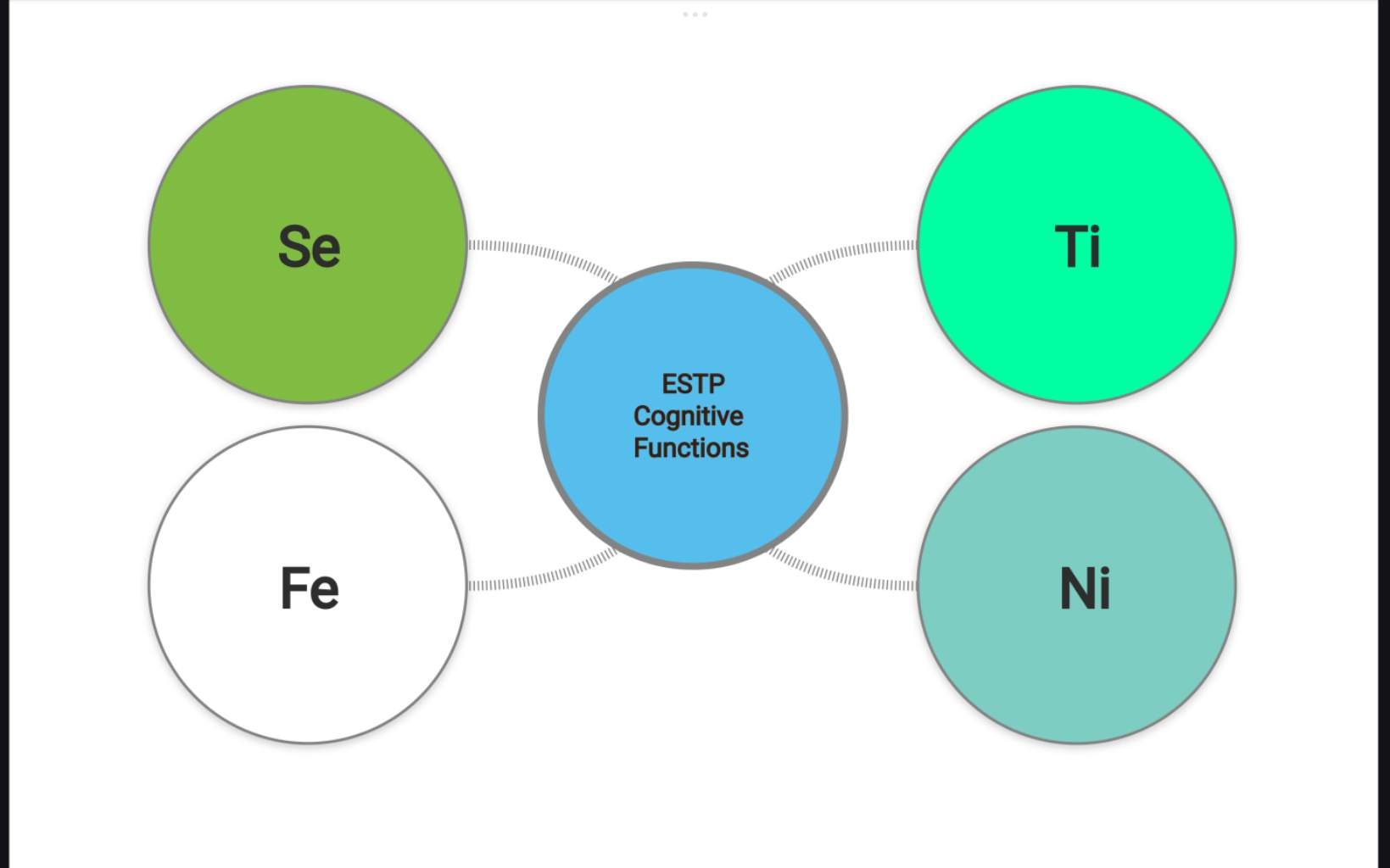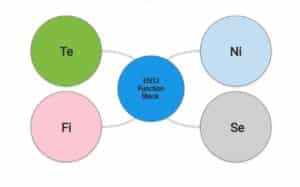Reading Time: 18 Minutes
Understanding “ESTP Cognitive Functions” is like discovering the hidden gears inside a machine. If you’re an ESTP, you might not even realize how your brain works—you just know you’re good at making quick decisions, living in the moment, and getting things done. But there’s a method to the madness. Your mind has four main gears, or cognitive functions, that help you navigate life in your unique way. Let’s dive into what these functions are and how they make you the dynamic, action-oriented person you are.
What Are Cognitive Functions?
Cognitive functions are like the tools your brain uses to understand and interact with the world. Think of them as the different settings on a camera. Depending on the situation, you switch between different modes—like zooming in for detail or using a wide lens to see the big picture. In the world of personality types, cognitive functions help explain why people think and act the way they do.
Now, in the Myers-Briggs Type Indicator (MBTI), each personality type has four main cognitive functions, and these functions work together to shape how you see the world, make decisions, and interact with others. If you’re an ESTP, your brain has its own favorite tools, or cognitive functions, that it loves to use.
You Might Like To Read: Understand ENTJ Function Stack (TeNi): A Very Simple Guide To Cognitive Functions

The Four Cognitive Functions of the ESTP
1. Extraverted Sensing (Se) – The Dominant Function
Imagine you’re at a party, and you’re the one who’s first on the dance floor, noticing the music, the lights, and everyone’s vibe. That’s Extraverted Sensing in action. As an ESTP, your dominant function is all about living in the moment. You’re tuned into what’s happening right here, right now. You pick up on details in your environment faster than most people, and you react quickly, whether it’s catching a falling glass or jumping into a conversation.
Se loves action and excitement. If life is a video game, Se is the part of you that wants to play on the highest difficulty setting, just for the thrill of it. But remember, while Se can make you the life of the party, it can also get you into trouble if you’re not careful—like when you decide to go skydiving without reading the instructions first.
2. Introverted Thinking (Ti) – The Auxiliary Function
Now, let’s say you’re at that same party, and someone asks you how the sound system works. Here’s where Introverted Thinking, or Ti, comes in. This function is like your inner engineer or detective. It loves figuring out how things work, solving puzzles, and finding logical answers to problems. Ti is your trusty sidekick that helps you make sense of the world.
For an ESTP, Ti supports Se by helping you analyze situations on the fly. You’re not just reacting to what’s happening—you’re also thinking about why it’s happening and how you can handle it better next time. Ti is all about efficiency and logic. It’s the reason you might spend hours tweaking your car engine to get that extra horsepower, even if no one else notices the difference.
But beware—sometimes Ti can make you overthink things. You might get so caught up in figuring out how something works that you forget to actually enjoy the experience. It’s like getting stuck in the settings menu of your video game instead of just playing the game.
3. Extraverted Feeling (Fe) – The Tertiary Function
Next, let’s talk about Extraverted Feeling, or Fe. This function is like your social radar. It helps you understand what other people are feeling and how to navigate social situations. Even though it’s not your strongest tool, as an ESTP, you still use Fe to connect with others and keep the peace when needed.
At the party, Fe is what helps you notice if someone’s feeling left out or if the group is starting to get bored. You might crack a joke to lighten the mood or suggest a new activity to keep everyone entertained. Fe helps you play well with others and keeps your social circle happy.
However, since Fe isn’t your main function, you might not always notice when you’re stepping on someone’s toes. It’s like knowing how to read the room but sometimes forgetting to check if everyone else is on the same page. But when you do tap into Fe, it can make you a great friend, partner, and teammate.
4. Introverted Intuition (Ni) – The Inferior Function
Last but not least, we have Introverted Intuition, or Ni. This function is like that mysterious old book on your shelf—you don’t use it often, but when you do, it can reveal some deep insights. For ESTPs, Ni is the function that helps you see the bigger picture and think about the future.
While Se is all about the present, Ni makes you pause and wonder where things are headed. Maybe at the party, you suddenly get a hunch that you should start planning your next big adventure or think about where your career is going. Ni gives you those “aha” moments, where everything just clicks, even if you’re not sure how.
But here’s the catch—because Ni is your least developed function, it can feel a bit like trying to read that old book in a language you barely understand. You might get glimpses of deeper meaning, but they’re often fleeting and hard to grasp. It’s like seeing the future through a foggy window. When you learn to trust those gut feelings, though, Ni can guide you toward some pretty amazing realizations.
The Interaction of ESTP Cognitive Functions
Let’s think of your cognitive functions as members of a band. Each one has a role to play, and when they work together, they create a pretty awesome tune—your personality!
How the Functions Work Together
First, we’ve got Extraverted Sensing (Se) as the lead guitarist. It’s flashy, fast, and loves to be in the spotlight. Se lives for the thrill of the moment, whether that’s jumping off a cliff (with a parachute, of course!) or making split-second decisions. It’s all about experiencing life with intensity and excitement. You’re the person who dives in headfirst, figuring things out as they happen.
Backing up Se, we have Introverted Thinking (Ti) on bass. Ti is quieter, but don’t underestimate it—it’s the brains of the operation. While Se is busy jamming out, Ti is analyzing everything, making sure the chords are right and the rhythm is solid. Ti loves to figure out how things work, breaking them down logically. It’s like your personal detective, always trying to understand the world and make sense of the chaos that Se sometimes creates.
Then there’s Extraverted Feeling (Fe) on vocals. Fe isn’t always front and center, but it knows how to work the crowd. It’s in tune with what people want and need, helping you connect with others and keep things harmonious. Fe makes sure everyone’s having a good time, making you the person people like to hang out with, even if you don’t always realize it.
Finally, Introverted Intuition (Ni) is the drummer, sitting in the back but setting the pace in subtle ways. Ni isn’t as loud or obvious as the other functions, but when it comes in, it adds depth to the whole performance. It’s the part of you that sometimes sees where things are heading before anyone else does, giving you those rare but powerful “aha” moments. Ni helps you think about the future, even if it’s just a fleeting thought while you’re in the middle of the action.
When these functions play together, they create the unique music of your life. Sometimes, Se might want to solo for too long, leaving Ti and Fe to play catch-up. Or Ni might throw in an unexpected drumbeat that throws everyone off. But when you learn to balance them, you get a dynamic, engaging performance—just like the way you navigate life.
Practical Applications of ESTP Cognitive Functions
So, how do these cognitive functions actually help you in the real world? Let’s break it down.
Career Paths and ESTP Cognitive Functions
You’ve got a knack for action, and your brain’s always on its toes, ready to react. This makes you a natural fit for careers that are fast-paced and require quick thinking. Picture yourself as an entrepreneur, firefighter, or paramedic—these are jobs where your Se gets to shine. You love being in the thick of things, making decisions on the fly, and getting results.
But don’t forget about Ti, your problem-solving buddy. You could also excel in fields that require logical thinking and troubleshooting, like engineering or mechanics. Your ability to figure out how things work means you can fix problems others might not even notice. Just try not to get too lost in the details; remember to keep moving forward.
Relationships and ESTP Cognitive Functions
In relationships, you bring energy and excitement. Your Se loves to keep things fun and spontaneous, whether it’s planning a surprise trip or just making everyday moments more lively. You’re great at living in the moment, which makes you a joy to be around.
But here’s where Fe comes in to help you out. Fe tunes you into what your friends, family, and partners are feeling. It’s like your emotional GPS, guiding you through the twists and turns of social life. You might not always notice when someone needs a bit more sensitivity or understanding, but when you do, you can be incredibly supportive and caring. And don’t worry if you’re not always the best at picking up on these cues—just remember that showing you care goes a long way.
Personal Growth and Self-Improvement
We all have room to grow, and that includes you. Developing your cognitive functions can help you navigate life even better.
Start with Se and Ti—your dynamic duo. Keep pushing yourself to explore new experiences (Se) while also taking the time to understand them deeply (Ti). Whether it’s picking up a new hobby or diving into a complex project, use these functions to keep life interesting and meaningful.
Next, work on your Fe. Practice tuning into the people around you. Ask yourself, “How is everyone feeling?” or “What can I do to make this situation better for someone else?” Little by little, you’ll get better at reading social cues and responding in ways that strengthen your relationships.
And don’t forget about Ni, your future-focused drummer. Take a moment every now and then to think about where you’re heading. What do you want in the long run? What’s your next big goal? Even if it’s just a vague idea, paying attention to Ni can help you make decisions that lead to a more fulfilling life.
Common Misconceptions About ESTPs
Let’s clear up a few things about ESTPs. People often get the wrong idea because they only see what’s on the surface. So, let’s bust some myths, shall we?
Misconception #1: ESTPs Are Reckless Daredevils
Okay, sure, you love a good thrill. But just because you’re the first to try bungee jumping doesn’t mean you’re reckless. People think ESTPs are always throwing caution to the wind, but that’s not true. You’re not jumping into things blindly—you’re just really good at assessing the situation quickly and deciding if it’s worth the risk. Your Extraverted Sensing (Se) helps you notice all the details in real-time, so while it might look like you’re being impulsive, you’re actually calculating the risks faster than most people can blink.
Misconception #2: ESTPs Don’t Care About Feelings
This one comes up a lot because you’re more focused on action than emotions. People might think you’re insensitive or that you don’t care about how others feel. But that’s not the whole story. While it’s true that your Extraverted Feeling (Fe) isn’t as strong as some other functions, it’s still there. You do care about people; you just show it in different ways—like solving their problems or making sure they’re having fun. You’re the friend who’ll drag someone out of a funk by taking them on an adventure, not by sitting around talking about feelings for hours.
Misconception #3: ESTPs Only Live for the Moment
Yes, you love living in the now, but that doesn’t mean you don’t think about the future at all. People often think ESTPs have no long-term goals or plans, but you do! It’s just that your Introverted Intuition (Ni), the part of you that thinks about the future, works in the background. It might not be as loud as your other functions, but it’s there, giving you those “aha” moments when you least expect them. So, while you’re busy enjoying the present, don’t be surprised when you suddenly get a great idea for what to do next with your life.
ESTP Cognitive Functions in Different Life Stages
Your cognitive functions don’t stay the same throughout your life. They grow and change, just like you do. Let’s take a little journey through the different stages of life and see how your ESTP brain works at each one.
Childhood and Adolescence: Discovering the World
As a kid, your Extraverted Sensing (Se) is in full swing. You’re that child who’s always climbing trees, racing bikes, and exploring every corner of the playground. You learn by doing, not by sitting still and listening to someone talk. School might be a bit of a challenge because, let’s face it, sitting at a desk all day isn’t your idea of fun.
But your Introverted Thinking (Ti) is already starting to show up, too. You’re the one who wants to know why things work the way they do, so you’re always asking questions and taking things apart (sometimes to the dismay of your parents).
Adulthood: Balancing Action with Insight
As you move into adulthood, your cognitive functions start to balance out more. You’re still driven by Se, always ready for the next big adventure, but your Ti becomes sharper. You’re better at planning and solving complex problems, whether it’s at work or in your personal life. Your Extraverted Feeling (Fe) also starts to come into play more often.
You might find yourself getting better at understanding the social dynamics at play in different situations and becoming more considerate of others’ feelings—just don’t expect to be the next Dr. Phil. Your Introverted Intuition (Ni) also starts giving you glimpses of the bigger picture. You begin to think more about where you’re headed in life and what you want to achieve, even if those thoughts come in short, intense bursts.
Later Life: Reflecting and Refining
As you get older, you might find that your focus shifts a bit. While you’ll always love action and excitement, you may start to appreciate your Ni more. You might spend more time reflecting on your life and thinking about what’s really important to you. Your Fe becomes more refined, and you could find that you’re more in tune with others’ emotions than you were when you were younger.
You might even start mentoring others, sharing your experiences and wisdom in a way that helps them navigate their own paths. And with your Ti, you’ll continue to enjoy solving life’s little puzzles, maybe just at a slightly slower pace than before.
Conclusion On ESTP Cognitive Functions
In a nutshell, “ESTP Cognitive Functions” are the tools your brain uses to power through life. Each function plays a role, whether it’s keeping you grounded in the present, helping you solve problems, understanding others, or occasionally making you think about the future. By knowing how these gears work together, you can better understand yourself and make the most of your natural strengths. So, whether you’re tackling a new challenge or just enjoying the ride, your cognitive functions are there to keep you on track.
Frequently Asked Questions
ESTP cognitive functions are the mental tools that shape how ESTPs think, act, and interact with the world. These functions include Extraverted Sensing (Se), Introverted Thinking (Ti), Extraverted Feeling (Fe), and Introverted Intuition (Ni). Together, they help ESTPs live in the moment, solve problems logically, understand social dynamics, and occasionally think about the future.
ESTP cognitive functions influence behavior by driving a love for action and excitement (Se), a knack for logical problem-solving (Ti), a growing awareness of others’ feelings (Fe), and rare but powerful insights about the future (Ni). These functions work together to make ESTPs quick on their feet, adaptable, and always ready for the next adventure.
Yes, ESTPs can develop their weaker cognitive functions over time. While Extraverted Sensing (Se) and Introverted Thinking (Ti) are naturally strong, ESTPs can work on enhancing their Extraverted Feeling (Fe) to improve social connections and their Introverted Intuition (Ni) to gain more long-term perspective. Personal growth involves balancing all these functions for a more rounded personality.
ESTP cognitive functions evolve as you age. In childhood, Se dominates as you explore the world. In adulthood, Ti sharpens, and Fe becomes more prominent in social interactions. As you get older, Ni starts to play a bigger role, helping you reflect on life and plan for the future. Each stage brings a new level of balance and understanding of your cognitive functions.
ESTPs thrive in fast-paced careers that require quick thinking and hands-on problem-solving. Jobs in fields like entrepreneurship, emergency services, sales, or engineering suit their strengths in Extraverted Sensing (Se) and Introverted Thinking (Ti). These careers allow ESTPs to be in the thick of the action, making decisions on the fly and solving problems as they arise.
If you like the post, then please don’t forget to share with your friends.
Some Of The Previous Posts




